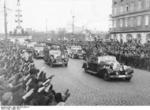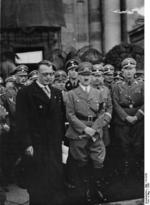
Austria
| Alliance | Axis - Minor Member Nation or Possession | |
| Possessing Power | Germany | |
| Entry into WW2 | 1 Sep 1939 | |
| Population in 1939 | 6,653,000 | |
| Civilian Deaths in WW2 | 123,700 | |
| - Civ Deaths from Holocaust | 65,000 |
Contributor: C. Peter Chen
ww2dbaseThe end of WW1 saw the Empire of Austria-Hungary in defeat. The empire was broken up, and the areas where ethnic Germans resided became the new Republic of German Austria on 12 Nov 1918. The provisional constitution of this new republic noted, in its Article 2, that "German Austria is part of the German Republic", and certain areas of the new nation was strongly in favor of an annexation with Germany, but the victorious powers of France and Italy forced Austria to sign the Treaty of Saint Germain which prevented such a merger and renamed the nation Republic of Austria. Politics in Austria in the 1920s was volatile, characterized by the struggle between the left-wing and Marxist-leaning Social Democratic Party of Austria and the ruling right-wing Christian Socialist Party which had ties to industrialists and the Roman Catholic Church. In Mar 1933, taking advantage of a formal error during a parliament vote and the confusing situation that ensued, Engelbert Dollfuß declared an emergency and took over legislative powers, thus entering the nation into the Austrofascist era. On 12 Feb 1934, the Austrian Civil War began after the fascist regime attempted to conduct a forced search of the headquarters of the Social Democratic Party. On 1 May 1934, the Dollfuß government introduced a new constitution which abolished the freedom of press and established a one party system of government. On 25 Jul 1934, Dollfuß was assassinated during a failed coup by Austrian Nazi Party members, but his successor Kurt Schuschnigg continued to uphold the new constitution.
ww2dbaseBorn an Austrian, Adolf Hitler had wished to annex Austria since he assumed power. However, the Austrian constitution, which outlawed political parties other than the one in power, made pro-German political activities in Germany difficult despite the Nazi Party already had well-established power bases in Austria by the mid-1930s. On 12 Feb 1938, at his residence of Berghof near Berchtesgaden, Bavaria in southern Germany, Hitler asserted pressure on Schuschnigg, and Schuschnigg gave in, allowing the Nazi Party to operate in Austria and appointing Nazi Party members Arthur Seyß-Inquart and Edmund Glaise-Horstenau ministerial positions. As pressure continued to arrive from Germany, Schuschnigg announced that he would allow a national referendum to decide the fate of Austria. While British intelligence report estimated that only about 35% of the population supported an annexation with Germany, Austrian Nazi Party fabricated that over 80% wished to join Germany, but those against it were conducting a violent campaign to silence them; the Austrian Nazi Party also requested German troops to intervene and stop the violence. On 11 Mar 1938, Germany gave Austria an ultimatum: surrender or face an invasion. Seeing no sign of support from the United Kingdom or France, Schuschnigg resigned. On the following day, 12 Mar, German troops marched into Austria unopposed, occupying the nation. On 10 Apr, a referendum was held, and an overwhelming 99.73% of the population voted for a merger with Germany; this referendum was commonly believed to have been rigged. As what Germany called Anschluß (also anglicized as Anschluss) was effected, Austria ceased to exist as a nation.
ww2dbaseDuring the war, the Austrian population in general acted as loyal citizens of the Nazi German Empire, including the implementation of anti-Semitic policies of the German government. At the time of the Anschluß, about 200,000 Jews lived in the capital of Vienna, with fewer in the countryside. Many of them began to suffer as early as 11 Mar 1938, the date that Germany gave Austria an ultimatum, when pro-German Viennese began drag Jews out into the open and beat them with clubs and fists, while others desecrated synagogues and looted Jewish-owned stores. During Krystallnacht (Night of the Broken Glass), which took place between 9 and 10 Nov 1938, 94 Viennese synagogues were damaged or destroyed, as well as countless Jewish-owned businesses and residences; the Krystallnacht marked the turning point where Nazi anti-Semitism transformed from rampant prejudice into the beginning of the Holocaust in Europe. Within the first 6 months of German occupation, about 45,000 Jews attempted to emigrate from Austria, but not all of the neighboring nations welcomed them; after the neighboring nations had complained to Germany of the unwelcomed influx of refugees, Germany recalled all Jewish passports on 5 Oct 1938. Without legal means to leave the Greater Germany, many Jews fell victim to the forced deportations of ghettos and concentration camps that came shortly. By the end of the war, 65,000 Austrian Jews would perish, which accounted for about half of civilian deaths in Austria during WW2.
ww2dbaseIn additions to the Jews, Austrian Catholics also suffered. State funding to the Catholic Youth Groups were cut in Oct 1938, and Archbishop of Salzburg Sigismund Waitz was placed under house arrest at around the same time; acts such as these ensured the Nazi German hold on power in Austria.
ww2dbaseDespite general cooperation with the German occupation, resistance groups existed. Most of them were members of left-wing political parties.
ww2dbaseOn 28 Mar 1945, American troops set foot on Austrian soil. On 30 Mar, Soviet troops entered the former Austrian border, capturing Vienna on 13 Apr.
ww2dbaseAfter the war, Austria was restored as a sovereign nation, but it was initially occupied by the United States, United Kingdom, France, and the Soviet Union from 9 May 1945, similar to the treatment of Germany at the same time. In the previous month, a new government headed by Karl Renner was established with the support of the Allies, leading Austria into an era named the Second Republic. The Allied occupation of Austria officially ended on 27 Jul 1955, and a truly independent Austria was restored for the first time since 1938.
ww2dbaseSources:
William Manchester, The Last Lion
Wikipedia
Last Major Update: Aug 2010
| Events Taken Place in Austria | ||
| Annexation of Austria | 12 Mar 1938 - 10 Apr 1938 | |
| Meeting at Brenner Pass | 18 Mar 1938 | |
| First Vienna Arbitration | 2 Nov 1938 | |
| Soviet Demands on Romania and the Second Vienna Arbitration | 27 Jun 1940 - 30 Aug 1940 | |
| Discovery of Concentration Camps and the Holocaust | 24 Jul 1944 - 29 Apr 1945 | |
| Southern Germany Campaign | 28 Mar 1945 - 2 May 1945 | |
| Battle of Vienna | 2 Apr 1945 - 13 Apr 1945 | |
| Weapons | ||
| MP 34 Submachine Gun | Schwarzlose MG M.07/12 Machine Gun | Steyr-Mannlicher M1895 Rifle |
| Mannlicher-Schönauer M1903 Rifle | Steyr M1912 Handgun | |
| Facilities | ||
| Mauthausen-Gusen Concentration Camp | Prison Camp | |
Photographs
 |  |  |  |
Austria in World War II Interactive Map
Please consider supporting us on Patreon. Even $1 per month will go a long way! Thank you. Please help us spread the word: Stay updated with WW2DB: |
Visitor Submitted Comments
19 Jul 2017 09:16:19 AM
Hi I am looking for a Mattias Klammer from Klagenfurt Area who was allegedly wounded on the Russian front and later died in Klagenfurt. Date Unknown I'm afraid.
He was in the Austrian Army but was put in the German Army.
Any help would be appreciated.
Thanks in advance.
13 Aug 2017 12:38:03 AM
I am looking for information about an Austrian named Michael Mlasko. He was imprisoned after WW II for "war crimes." Is there any way to find further information out about him? Where he was imprisoned, etc.?
20 Aug 2017 06:54:45 AM
Hi,
I am looking for Adolf Nagy from Wien, who served in German Army in World War II. He was stationed in the east of Slovakia, close to Dukla, where were the biggest fights with resistance and Russians. My granddad was a child then and they stayed in my graddad's house. He has a very fond memories of him as Adolf was a very decent, nice man. My granddad just wanted to know if he survived the war and what happened to him. Thank you. I have his address (Adolf Nagy)from then, just don't want to post it here. At the time he was stationed in Slovakia ( I assume around 1943-1944) he was about 40 years old, from granddad's recollection. Thank you. Petra
14 Jan 2018 10:42:37 PM
Looking for info on a female MIHALIK (unknown first name) was unwed mother of Franz Mihalik born Allerheiligen bei Wildon ,Styria , Austria 1944.Mother possibly from Ukraine or Austria. Any Austrian Mihalik please reply.Thank you.
25 Aug 2018 04:26:57 AM
I am looking for information on my Grandfather Heinrich Karl Blauensteiner that was a member of the Wermacht.
13 Sep 2019 07:41:45 PM
Warhona Austria, Has anyone heard of this location in Austria? My ancestors are documented as living there, Name Zadarlick, Zagarlick, Zaharlick
24 Feb 2022 04:23:32 AM
To Elaine Walsh - Adam Zadarlik (Sr & Jr) are documented living in Austria & coming to Ellis Island in the early 1900's, as well as Istvan Zadarlik coming from Hamburg (my great great Grandfather).
I would also be interested in more heritage information on Zadarlik.
All visitor submitted comments are opinions of those making the submissions and do not reflect views of WW2DB.

- » Wreck of Teruzuki Found (27 Jul 2025)
- » USS Orlean's Bow Found (22 Jul 2025)
- » The Emperor of Japan Planned to Honor WW2-era Japanese POWs in Mongolia (4 Jul 2025)
- » US State Lawmaker John Winter Caught Using Racial Slur "Jap" and Apologized (11 Jun 2025)
- » US Government Plans to Purge WW2 Information (17 Mar 2025)
- » See all news
- » 1,181 biographies
- » 337 events
- » 45,111 timeline entries
- » 1,247 ships
- » 350 aircraft models
- » 207 vehicle models
- » 376 weapon models
- » 123 historical documents
- » 261 facilities
- » 470 book reviews
- » 28,471 photos
- » 365 maps
Captain Henry P. Jim Crowe, Guadalcanal, 13 Jan 1943
Please consider supporting us on Patreon. Even $1 a month will go a long way. Thank you!
Or, please support us by purchasing some WW2DB merchandise at TeeSpring, Thank you!
27 Apr 2017 03:47:10 PM
Looking for info on Metro Grumetza or similar spelling. who listed with the Austian Army around 1903